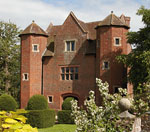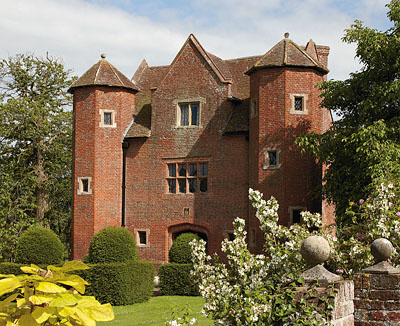Country House owners: Upgrade your listing
Changes to planning rules provide just one reason why it might be worthwhile asking to have the category of your listing reconsidered


For the past few months, ever since finishing a major two-year restoration project at Upton Cressett Hall, a Grade II*-listed moated medieval manor with a noted Elizabethan gatehouse near Bridgnorth in Shropshire (featured on the cover of Country Life on April 11, 2002), I have been considering applying to English Heritage (EH) to have our family property upgraded to Grade I.
The main reason for this is that the current listing information is almost comically inaccurate. Dating from 1954, it gets off to a bad start by getting the property's name wrong, calling it ‘Upton Hall', and goes downhill from there, stating that the house was built in about 1540-1580 (it dates from 1380) and is dilapidated and unoccupied (following a renovation in the early 1970s, my family has been living happily at Upton Cressett Hall for the past 40 years).
It concludes that the gatehouse (described by Simon Jenkins as ‘an Elizabethan gem' in England's Thousand Best Houses) is dilapidated and has one small room on the first floor. In fact, this ‘small room' is part of the suite that Prince Rupert was given when he stayed at Upton Cressett in the Civil War, and the adjoining bedroom has played host to Margaret Thatcher and Elizabeth Hurley.
However, I'm also convinced that the perception of the planning authority as a conservation fundamentalist is largely an outdated myth. During our restoration, I had several ugly pre- and post-Second World War casement windows around the front of the house replaced with new mullion windows with leaded lights-to match those of the gatehouse-and had no problem with the planners. They seemed relieved that I was restoring the 16th-century architectural spirit to the house.
This fresh approach to conservation should help to get local economies rolling again, as many of the historical improvements that owners of listed buildings have long wanted to make, but have been refused permission for in the past, could now be given consent. This is especially true if the likely forthcoming change in policy will allow them to nominate parts of a property for Grade I-or Grade II*-listed status, while applying normal planning rules to those areas not covered. ‘The idea is to protect the important details, designating, say, the front of a Georgian house as being Grade I-listed, but not the rear, which may be an ugly Victorian addition, and to allow normal planning consent for that,' says a Government source.
Another important reason for applying for the listings upgrade is that I'm deeply concerned about the dilution of ‘heritage protection' in both the draft National Planning Policy Framework (NPPF) and the Localism Bill. Faced with a planning free-for-all across the country, owners of historic houses need to embrace their listed status as one of few statutory defences they may have against unwanted developments.

* Give Country Life for Christmas and save up to 40%
Sign up for the Country Life Newsletter
Exquisite houses, the beauty of Nature, and how to get the most from your life, straight to your inbox.
Currently, of the 400,000 listed buildings in this country, only about 2.5% are Grade I. Surely the Government has a duty to protect this heritage? It seems likely that Ministers may concede this point, largely thanks to the National Trust, which is lobbying for the old presumption in favour of conservation to be reinstated in the NPPF for buildings of national importance.
If this is the case, then added protection may be given to Grade I- and possibly Grade II*-listed buildings, especially those that contribute to the economy by being part of the ‘heritage tourism' industry. So how do you go about applying for an upgrade? It's actually very simple. The first step is to check your listing information. Last May, EH launched the National Heritage List for England (www.english-heritage.org.uk), a statutory list of ‘all designated heritage places such as listed buildings and scheduled monuments', backed up by a vast online library of images.
For the first time, people can see why a property has been designated and what its historic or special architectural interest is. EH admits freely that many of the listings are out of date. To address this, it is inviting owners of listed properties to check their entries and point out any mistakes.
Amending minor details in the listing can be done easily by email. However, this process doesn't apply to a ‘change in the Grade or status of a building'. So, in order to get Upton Cressett upgraded to Grade I, I will need to make a formal application to EH, which can be done online and needs to be complete with photographs of the property, ownership details and any documentary evidence to support my request.
Like anybody contemplating a formal proposal, I am not without nerves about the humiliating prospect of being rejected. Whether having hosted Miss Hurley and Baroness Thatcher will strengthen my case remains to be seen.
Country Life is unlike any other magazine: the only glossy weekly on the newsstand and the only magazine that has been guest-edited by HRH The King not once, but twice. It is a celebration of modern rural life and all its diverse joys and pleasures — that was first published in Queen Victoria's Diamond Jubilee year. Our eclectic mixture of witty and informative content — from the most up-to-date property news and commentary and a coveted glimpse inside some of the UK's best houses and gardens, to gardening, the arts and interior design, written by experts in their field — still cannot be found in print or online, anywhere else.
-
 Vertigo at Victoria Falls, a sunset surrounded by lions and swimming in the Nile: A journey from Cape Town to Cairo
Vertigo at Victoria Falls, a sunset surrounded by lions and swimming in the Nile: A journey from Cape Town to CairoWhy do we travel and who inspires us to do so? Chris Wallace went in search of answers on his own epic journey the length of Africa.
By Christopher Wallace Published
-
 A gorgeous Scottish cottage with contemporary interiors on the bonny banks of the River Tay
A gorgeous Scottish cottage with contemporary interiors on the bonny banks of the River TayCarnliath on the edge of Strathtay is a delightful family home set in sensational scenery.
By James Fisher Published
